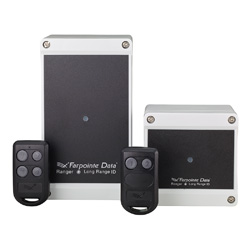 |
| Recently there has been great interest in long range reading (433 MHz technology) |
For the last two decades, the primary contactless technology used in access control systems has been the proximity card (125 kHz technology). In the last decade, proximity cards have been augmented by the smart card (13.56 MHz technology). And that's the way it has been until just recently. All of a sudden, there has been great interest in long range reading (433 MHz technology).
Merging tradition and convenience
New 433 MHz receivers support either 2-button or 4-button transmitters to open two to four different doors from ranges up to 200 feet (61 m). Each button outputs transmitter data over separate Wiegand outputs yet the receiver installs just like a proximity reader for easy integration with popular proximity or contactless smart card access control systems.
Equipped standard with a weather-resistant potted proximity or contactless smart card module, a 433 MHz transmitter can be used as a presentation-style access credential. Each transmitter integrates the convenience of long range identification with traditional proximity or contactless smart card access control.
For example, if a site requires employees to access a parking structure (gate/barrier) and a door (building entrance), the 433 MHz solution will enable each user to access both the long range and proximity applications with a single transmitter. For the parking structure, the user presses the transmitter button from the secure convenience of their vehicle (without lowering the window) and, when wanting to gain access at the door, they simply present the transmitter to the building’s proximity reader. Since identical data is transmitted upon button press or presentation, each user needs only be enrolled once in the access control system.
Long range reading at ISC West 2015
The applications for long range reading discussed with attendees at ISC West 2015 in Las Vegas were varied and, oftentimes, way beyond what we had ever imagined. Of course, a popular use is at gated communities such as at the main gate of the Kolea at Waikoloa Beach Resort on the Big Island of Hawaii.Those entering the main gate in their car use a 433 MHz transmitter which is read by the Farpointe WRR-4+ receiver integrated into a Linear gate entry system via industry standard Wiegand protocol.
One manufacturer of very valuable products discussed how they had vehicle barriers installed on the single lane road that leads to the warehouse. Of course, every time one of their own truck drivers entered, it had to stop, open a window and present a proximity card to lift the barricade to enter. With the long range transmitter in the cab and receiver at the barrier, the driver now simply presses one of the buttons on the transmitter ahead of time and the barrier lifts, letting them through. An airport security director discussed this same type of application with an addition. Using a second button, the driver also opens the hangar's door so he can drive right in.
One of the reasons that the 433 MHz solution works better than active cards and readers in such secure applications is because, versus the card, which could activate more than one device or door at a time, the transmitter holder selects exactly the mechanism to be immediately triggered |
Another popular application that came up repeatedly was to arm the front receptionist with the 433 MHz transmitter. To sum up the different takes on the applications discussed, Button 1 could be used to let visitors into the front door, Button 2 would let certain visitors into the door off the lobby into the main part of the facility and Button 3 to be used as a panic button or alarm for any incident seen by the receptionist. Button 4 would turn off the alarm.
Additional Benefits
One of the reasons that the 433 MHz solution works better than active cards and readers in such secure applications is because, versus the card, which could activate more than one device or door at a time, the transmitter holder selects exactly the mechanism to be immediately triggered. Active cards commonly send out a consistent ring of communication, always searching for a reader. Conversely, the 433 MHz solution send its directed signal straight to the receiver (yes, you may point it). Plus, the signal is only "alive" while the user presses the button.
In addition, the system takes advantage of a secure digital anti-playback routine, based upon a custom rolling code variant of the Tiny Encryption Algorithm (TEA). The anti-playback feature virtually eliminates the risk of code sniffing and unauthorised duplication. Every time a button is pressed, the encrypted rolling code changes, preventing a sniffed code from being successfully retransmitted.
Using standard 26-bit Wiegand protocol and featuring standard mounting holes, the readers can be used as "add-on" or "wire-in" receivers. Using custom Wiegand protocols, such as 32- or 36-bit formats, the long-range system can be made even more secure. This prevents credential duplication and ensures that the readers will only collect data from this single system's coded credentials. The transmitter’s lithium cell battery is tested to exceed 250,000 presses.
Since 433 MHz is a standard harmonised around the world, receivers can be used globally.








































